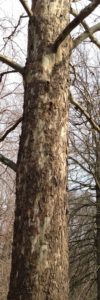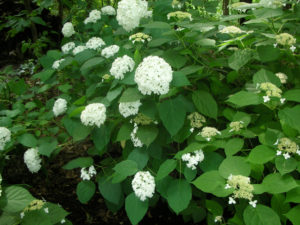Q. We have a large sycamore tree in our yard. Every summer it sheds its bark over a few weeks’ time. I think as it grows it is growing new bark and losing the old bark. Am I correct? – J.C., Walton, Ind.
A. You’re on the right track. Peeling bark is normal, and is a key ornamental characteristic for a sycamore, also known as American planetree. The bark starts out a bit gray-brown and as the bark matures, the outer layer peels off in large sheets to reveal a lighter-colored, creamy, off-white inner layer. The result appears a bit like a camouflage pattern. No need to worry – the tree is not harmed by the peeling bark.
Q. We have several hydrangea plants that bloom beautifully every spring. The stems grow about 3 feet tall each year and have large white flowers. Soon after they reach full bloom, the stems get top heavy and lay down. One year I tried unsuccessfully to tie them up so they wouldn’t fall down. Is there anything that can keep them from falling over? – C.F., Marshall County
A. Many of our summer flowering hydrangeas have flower clusters so large that they cause the stems to flop over as you’ve described, especially following heavy rains. Most hydrangeas that are hardy here die back to the ground every year, and the new stems that grow each year are a bit weak-wooded compared to the extra-large flower clusters. There are a number of ways to stake or support the stems, but you’ll want to start early in the season before the blossoms come on. You can use a short fence or trellis that will support the stems. You can also find some cage-like structures at your local garden center, similar in design to tomato cages. Some gardeners leave the old stiff dead stems rather than prune them off. It looks a bit unsightly early on, but soon will be mostly or entirely concealed by the foliage. Some newer, improved cultivars are less prone to flopping.
Q. I noticed 3-4 Japanese Beetles in my front yard last summer. Four weeks ago, a few were on the deck in the back yard. They began swarming in the back yard 3 weeks ago. They hover 4-5 inches above the lawn, which is healthy. There is one large silver maple and two large Arborvitae in the front yard, one young Rubrum Petite maple in the back yard. No other foliage in the yard. There’s no sign of beetle damage on any tree. Should I treat only the lawn and with what? – O.W., Lafayette, Ind.
A. I do not recommend that you treat your lawn if you are not seeing any damage. Otherwise healthy plants including turfgrass can tolerate small numbers of insect pests. Keep an eye out next year and if damage to plants warrants action, the timing of insecticide application will be critical. Purdue Extension Publication E-75, Japanese Beetles in the Urban Landscape has excellent information to guide you. It is available at https://www.purdue.edu/hla/sites/yardandgarden/wp-content/uploads/sites/2/2017/08/E-75.pdf.

